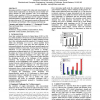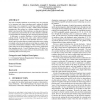72 search results - page 5 / 15 » Electrical interconnects revitalized |
HOTI
2008
IEEE
14 years 4 months ago
2008
IEEE
Optical interconnects are useful for high-performance electronic computing systems when the number-ofchannels, the bit-rate per channel, the channel density, and the communication...
CORR
2011
Springer
13 years 1 months ago
2011
Springer
Many complex systems, from power grids and the internet, to the brain and society, can be modeled using modular networks. Modules, densely interconnected groups of elements, often...
ECIS
2004
13 years 11 months ago
2004
Speed and availability of information, delivered in past years by Internet technologies, made it easier for any company to outsource primary activities, which resulted in unbundli...
DAC
2006
ACM
14 years 10 months ago
2006
ACM
Increasing resistivity of copper with scaling and rising demands on current density requirements are driving the need to identify new wiring solutions for deep nanometer scale VLS...
ISCA
2009
IEEE
14 years 4 months ago
2009
IEEE
Tens and eventually hundreds of processing cores are projected to be integrated onto future microprocessors, making the global interconnect a key component to achieving scalable c...


